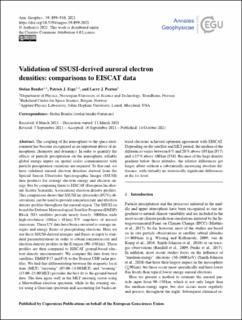| dc.contributor.author | Bender, Stefan | |
| dc.contributor.author | Espy, Patrick Joseph | |
| dc.contributor.author | Paxton, Larry J. | |
| dc.date.accessioned | 2021-10-15T06:45:57Z | |
| dc.date.available | 2021-10-15T06:45:57Z | |
| dc.date.created | 2021-10-14T11:10:24Z | |
| dc.date.issued | 2021 | |
| dc.identifier.citation | Annales Geophysicae. 2021, 39 (5), 899-910. | en_US |
| dc.identifier.issn | 0992-7689 | |
| dc.identifier.uri | https://hdl.handle.net/11250/2823156 | |
| dc.description.abstract | The coupling of the atmosphere to the space environment has become recognized as an important driver of atmospheric chemistry and dynamics. In order to quantify the effects of particle precipitation on the atmosphere, reliable global energy inputs on spatial scales commensurate with particle precipitation variations are required. To that end, we have validated auroral electron densities derived from the Special Sensor Ultraviolet Spectrographic Imager (SSUSI) data products for average electron energy and electron energy flux by comparing them to EISCAT (European Incoherent Scatter Scientific Association) electron density profiles. This comparison shows that SSUSI far-ultraviolet (FUV) observations can be used to provide ionization rate and electron density profiles throughout the auroral region. The SSUSI on board the Defense Meteorological Satellite Program (DMSP) Block 5D3 satellites provide nearly hourly, 3000 km wide high-resolution (10 km×10 km) UV snapshots of auroral emissions. These UV data have been converted to average energies and energy fluxes of precipitating electrons. Here we use those SSUSI-derived energies and fluxes as input to standard parametrizations in order to obtain ionization-rate and electron-density profiles in the E region (90–150 km). These profiles are then compared to EISCAT ground-based electron density measurements. We compare the data from two satellites, DMSP F17 and F18, to the Tromsø UHF radar profiles. We find that differentiating between the magnetic local time (MLT) “morning” (03:00–11:00 MLT) and “evening” (15:00–23:00 MLT) provides the best fit to the ground-based data. The data agree well in the MLT morning sector using a Maxwellian electron spectrum, while in the evening sector using a Gaussian spectrum and accounting for backscattered electrons achieved optimum agreement with EISCAT. Depending on the satellite and MLT period, the median of the differences varies between 0 % and 20 % above 105 km (F17) and ±15 % above 100 km (F18). Because of the large density gradient below those altitudes, the relative differences get larger, albeit without a substantially increasing absolute difference, with virtually no statistically significant differences at the 1σ level. | en_US |
| dc.language.iso | eng | en_US |
| dc.publisher | European Geosciences Union | en_US |
| dc.rights | Navngivelse 4.0 Internasjonal | * |
| dc.rights.uri | http://creativecommons.org/licenses/by/4.0/deed.no | * |
| dc.title | Validation of SSUSI-derived auroral electron densities: comparisons to EISCAT data | en_US |
| dc.type | Peer reviewed | en_US |
| dc.type | Journal article | en_US |
| dc.description.version | publishedVersion | en_US |
| dc.source.pagenumber | 899-910 | en_US |
| dc.source.volume | 39 | en_US |
| dc.source.journal | Annales Geophysicae | en_US |
| dc.source.issue | 5 | en_US |
| dc.identifier.doi | 10.5194/angeo-39-899-2021 | |
| dc.identifier.cristin | 1945856 | |
| cristin.ispublished | true | |
| cristin.fulltext | original | |
| cristin.qualitycode | 1 | |

